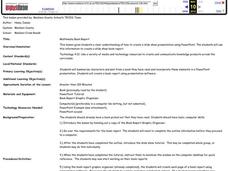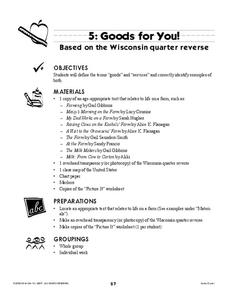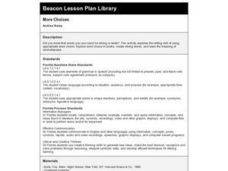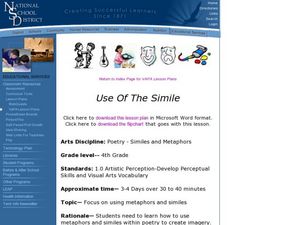Curated OER
Kids/Blocks/Learning
Help develop graphing skills in your young learners.. They create a picture graph, represent 1:1 correspondence, represent same and different, and draw conclusions. They write an experience story about the conclusions drawn from the...
North Carolina Standard Curriculum
Rhythm Counting
Understanding time signatures and rhythm counting are two very important parts of playing an instrument well. Here are three basic lessons rolled into one that prompt upper graders to play their instruments with care. They'll practice...
Curated OER
Writing as a group activity
Did you know that 50% of all Americans can trace a relative who traveled through Ellis Island? Relive these journeys with your class and then provide sentence strategy templates for them to use to compose their own informative...
Curated OER
The Role of the Opera Orchestra
Students listen to and examine a recording of the opera Don Pasquale and study the various musical instruments in an orchestra. They discuss the difference between a symphony orchestra and an opera orchestra. Finally they play the music...
Curated OER
Lunar Real Estate
Students investigate the aspect of colonizing the moon by comparing techniques that are used on Earth. The colonization takes place with the planning of a hypothetical model. The model is used as a point of discussion and target...
Curated OER
Multimedia Book Report
Learners take a book they've read previously and create a multimedia book report. They use the book report graphic organizer (attached) to plan their PowerPoint presentation. A thorough rubric is provided for you to ease grading. There's...
Curated OER
Great Rivers 2: The Ups and Downs of River Flooding
Second in a three-part lesson on rivers, this lesson focuses on the flooding that occurs in riparian locations. First, learners take a look at facts about the Amazon River. They read online materials and fill in a worksheet as they...
Curated OER
Goods for You!
Have your class learn about Wisconsin and farming. Learners begin by listening to stories that describe farming and engage in a discussion of goods and services. They could also compare the goods and services provided in different states.
Curated OER
More Choices
Fourth graders create onomatopoeia for a variety of things such as a mean dog, a crying baby or a doorbell ringing after exploring word choice as used by authors in selected books. They complete a Word Choice worksheet that is attached.
Curated OER
Time Management
Students are taken through the design process to develop a system of time management for themselves and others. They practice participating in a critique of other students' time schedules and modify and improve their initial time...
Curated OER
Use of the Simile
Fourth graders identify and write their own similes. In this literary devices instructional activity, 4th graders define and identify similes. The teacher scaffolds the instructional activity so that all students can write their own...
Curated OER
Ancient Egypt: Connecting Literature and Geography
Students brainstorm prior knowledge of Ancient Egypt, locate Egypt on map of Africa and on world map, watch King Tut film, discuss term biography, and map geographical information mentioned in stories and documentaries about Ancient Egypt.
Curated OER
B B BEE!!
Students recognize phonemes in spoken words and match letters to phonemes. They focus on the letter /b/ and the meaningful representation of the /b/. They read 'The Honeybee and the Robber' by Eric Carle and hold up their bees when...
Curated OER
Talking About the Past
Twelfth graders practice using the simple past and the present perfect. They use a timeline and practice using them. They fill out a worksheet and review it as a class.
Curated OER
The Nesting Habits of Folders
Students create an organized web of nested grade level folers. Within each grade level folder, they create a Language Arts/Social Studies folder and a Math/Science folder. All folders be color coded.
Curated OER
Community Quilt
Second graders use prior knowledge about the community to create a quilt. They use complete sentences to explain their block and also use oral language skills to tell about their caption for their quilt piece.
Curated OER
Sense-Ability
Students use comparisons, graphing, patterning, and sorting, and develop language skills as they explore the five senses.
Curated OER
History in the Making: The Tortilla
Fourth graders examine the history of the tortilla and extend the study across the curriculum. In this history of the tortilla lesson, 4th graders research the background of the tortilla, determine the ingredients, and work with the...
Curated OER
Personal Learning Project
Students watch the movie "Cool Runnings", they identify and categorze examples of dreams and examples of goals reflected in the movie. They work in small groups and discuss the movie to begin to generate the concepts behind the terms...
Curated OER
Let's Play Scrabble!
What do Alfred Mosher Butts, James Brunot, and Jack Straus have in common? They were all instrumental in the development of Scrabble. Class members will discover these facts and many more as they conduct a WebQuest to gather, organize,...
Curated OER
Reading ABC's
Students create a slide presentation that contains text, images, sounds, and navigation buttons. They explore PowerPoint and use the different tools and basic slide-creation options.
Curated OER
English Lessons for Today’s Diplomats!
Young scholars read an article on the English language. In this ESL lesson, students explore the meaning of the term 'diplomatic English,' then complete several activities centered around the article. Activities include vocabulary,...
Curated OER
Get ready, get set? READ!!!
Students participate in reading exercises to improve speed, fluency, and comprehension. As a class, students practice reading skills to increase their speed and comprehension. Partners take turns competing in a reading race while reading...
Curated OER
ART- LANGUAGE OF SYMBOLS
Students discuss how color construct meaning in art. They will demonstrate a technical knowledge and creative use of formal elements and principals of design. Students then discuss the way their selection of color contributed to their work.

























